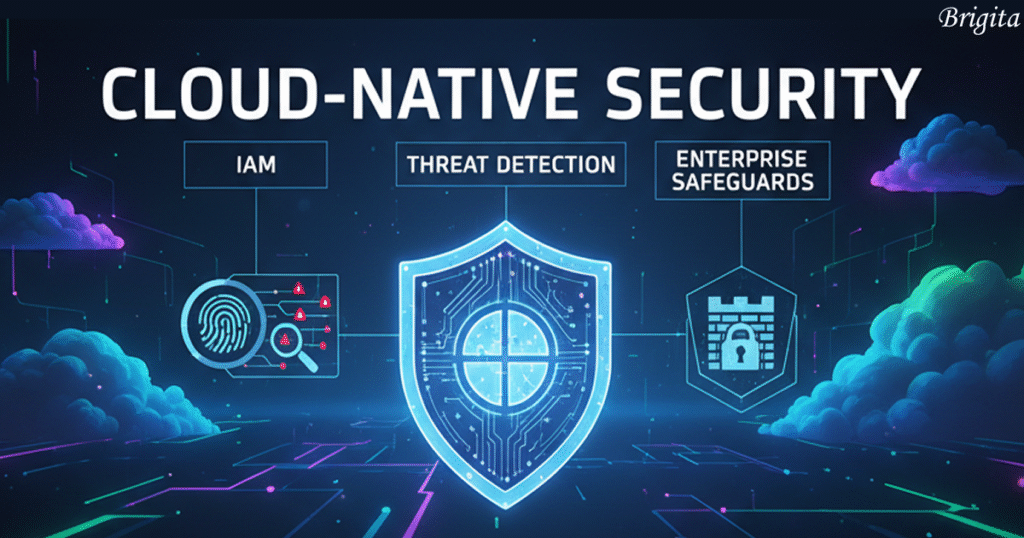As more businesses move their applications and data to the cloud, the way we think about security has completely changed. Traditional on-premise security models don’t fit the fast, scalable, and flexible world of cloud-native applications. Instead, organizations now need modern approaches that protect workloads, users, and data without slowing down innovation.
In this blog, we’ll break down three important pillars of cloud-native security—Identity and Access Management (IAM), Threat Detection, and Enterprise Safeguards—in simple terms, so you can understand how they work together to keep businesses secure.
What Is Cloud-Native Security?

Cloud-native security is all about protecting applications that are built and run in cloud environments (like AWS, Azure, or Google Cloud). Unlike traditional software that lives on company servers, cloud-native applications are distributed, containerized, and highly dynamic.
This flexibility is great for innovation, but it also means there are more “entry points” for attackers. Security in this environment must adapt to changes in real-time and protect across containers, microservices, APIs, and multiple cloud platforms.
Identity and Access Management (IAM): The First Line of Defense
Imagine your cloud infrastructure as a building with hundreds of doors. If anyone could walk in, chaos would follow. That’s where Identity and Access Management (IAM) comes in—it decides who gets access, what they can do, and for how long.
Key Principles of IAM in Cloud-Native Security:
1.Least Privilege Access
Users should only get the exact level of access they need, nothing more. For example, a developer may access test environments but not production systems.
2.Multi-Factor Authentication (MFA)
Adding an extra security step (like OTP on your phone) ensures even if a password is stolen, accounts remain safe.
3.Role-Based Access Control (RBAC)
Instead of giving permissions to individuals, roles are assigned. Example: “HR Role” has access to employee data, “Finance Role” has access to billing.
4.Continuous Access Monitoring
IAM isn’t just about granting access once—it also monitors if that access is being misused.
In short, IAM makes sure that only the right people, with the right permissions, can reach sensitive data or systems in the cloud.
Threat Detection: Spotting Risks Before They Spread
Even with IAM in place, attackers may still find ways to sneak in. That’s why threat detection is essential.
Threat detection uses AI, machine learning, and monitoring tools to continuously analyze user behavior, system logs, and network activity to spot anything unusual.
How Threat Detection Works in the Cloud:
Anomaly Detection: If a user logs in from India at 9 AM and suddenly from Europe 10 minutes later, the system flags it.
Malware Identification: Advanced scanning tools catch malicious files before they spread.
API Monitoring: Since cloud apps rely heavily on APIs, monitoring them prevents attackers from exploiting weak points.
Automated Alerts & Response: When threats are detected, alerts are sent instantly, and in some cases, systems can auto-block suspicious actions.
The goal is to stop attacks early before they escalate into full-blown breaches.
Enterprise Safeguards: Building a Culture of Security
Cloud-native security isn’t just about tools; it’s about enterprise-wide safeguards—practices and policies that keep security at the heart of every operation.
Common Enterprise Safeguards:
1.Zero Trust Security
Never trust, always verify. Every user, device, and application must prove its identity continuously.
2.Data Encryption
Encrypting data both at rest (stored) and in transit (moving across networks) ensures sensitive information remains unreadable to attackers.
3.Security Automation
Automated scripts and workflows help patch vulnerabilities quickly, manage configurations, and respond to incidents faster.
4.Compliance and Audits
Regularly checking against standards like ISO 27001, GDPR, HIPAA, and NIST ensures enterprises meet legal and industry requirements.
5.Employee Awareness Training
Many attacks succeed because of human error. Training employees on phishing, safe password practices, and secure usage of cloud apps is just as important as technology.
Why These Three Pillars Work Best Together
1.IAM ensures that access is controlled.
2.Threat Detection ensures any suspicious behavior is caught early.
3.Enterprise Safeguards ensure that the whole company, from policies to people, follows a culture of security.
Together, these create a layered defense strategy, reducing the chances of breaches, minimizing risks, and protecting sensitive business data.
Final Thoughts
Cloud adoption is no longer optional—it’s the future. But without proper security strategies, enterprises expose themselves to data breaches, compliance penalties, and loss of customer trust.
By focusing on Identity and Access Management, Threat Detection, and Enterprise Safeguards, organizations can secure their cloud-native environments without slowing down innovation.
Security in the cloud isn’t a one-time setup—it’s an ongoing journey. With the right mix of tools, policies, and awareness, businesses can build a strong shield around their cloud infrastructure and move forward with confidence.
Want to strengthen your cloud-native security strategy?
At Brigita, we help enterprises build robust IAM frameworks, implement advanced threat detection, and establish enterprise safeguards tailored to your business.
Search
Categories

Author
-
Nandhakumar is a passionate Graphic Designer who transforms ideas into powerful visual stories that inform, inspire, and persuade. As an emerging creative professional, he is eager to grow from the ground up—constantly learning new tools, experimenting with fresh concepts, and refining his craft. For him, challenges spark creativity, with music serving as a trusted source of inspiration that helps ideas flow and designs come to life. Outside of design, Nandhakumar is a cinema lover who enjoys exploring stories on the big screen, finding both inspiration and relaxation through films.
